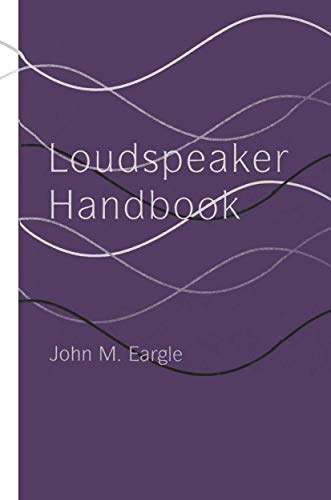Articoli correlati a Loudspeaker Handbook

The prospect of writing a book on loudspeakers is a daunting one, since only a multivolume encyclopedia could truly do justice to the subject. Authors writing about this subject have generally concentrated on their own areas of expertise, often covering their own specific topics in great detail. This book is no exception; the author's background is largely in professional loudspeaker application and specification, and the emphasis in this book is on basic component design, operation, measurement, and system concepts. The book falls largely into two sections; the first (Chapters 1-9) emphasizing the building blocks of the art and the second (Chapters 10-16) emphasizing applications, measurements, and modeling. While a thorough understanding of the book requires a basic knowledge of complex algebra, much of it is understandable through referring to the graphics. Every attempt has been made to keep graphics clear and intuitive. Chapter 1 deals with the basic electro-mechano-acoustical chain between input to the loudspeaker and its useful output, with emphasis on the governing equations and equivalent circuits. Chapter 2 is a survey of cone and dome drivers, the stock-in-trade of the industry. They are discussed in terms of type, design, performance, and perfor- mance limits. Chapter 3 deals with magnetics. Once a source of difficulty in loudspeaker design, magnetics today yields easily to modeling techniques. Chapter 4 discusses low-frequency (LF) system performance, primarily from the viewpoint of Thiele-Small parameters. We also discuss some of the multi- chamber LF systems that became popular during the eighties.
Le informazioni nella sezione "Riassunto" possono far riferimento a edizioni diverse di questo titolo.
Contenuti:
1 Electroacoustical Engineering Fundamentals.- 1.1 Introduction.- 1.2 A Simple Electrical Series Resonant Network.- 1.3 A Simple Mechanical Resonant System.- 1.4 Impedance and Mobility Analogies.- 1.5 Combining Electrical and Mechanical Domains.- 1.6 Combining Mechanical and Acoustical Domains.- 1.7 Directional Characteristics.- 1.8 Cone Excursion, Power, and Pressure Relationships.- 2 Cone and Dome Drivers.- 2.1 Introduction.- 2.2 Mechanical Construction Details of the Cone Driver.- 2.3 The Moving System.- 2.4 Variations on the Cone Transducer.- 2.5 Dome Drivers.- 2.6 Distortion in Cone and Dome Drivers.- 3 Principles of Magnetics.- 3.1 Introduction.- 3.2 Fundamentals: Hysteresis and Load Line.- 3.3 Details of the Magnetic Circuit.- 3.4 Linearity Issues.- 3.5 Temperature Rise and Demagnetization.- 3.6 Modeling of Magnetic Phenomena.- 3.7 Magnetic Shielding.- 4 Low-Frequency Systems and Enclosures.- 4.1 Introduction.- 4.2 Thiele-Small Parameters.- 4.3 Sealed Low-Frequency System Analysis.- 4.4 Ported Low-Frequency System Analysis.- 4.5 Some Useful Alignments.- 4.6 The Passive Radiator.- 4.7 Transmission Line Systems.- 4.8 Curiosities from the Past.- 4.9 Multichamber Bandpass Low-Frequency Systems.- 4.10 Transducers in Acoustical Series and in Parallel.- 4.11 Alignment Shifts.- 5 Dividing Networks and Systems Concepts.- 5.1 Introduction.- 5.2 Basic Dividing Networks.- 5.3 Stock Networks and Autotransformers.- 5.4 Combining Acoustical and Electrical Poles.- 5.5 Off-Axis Lobing Effects.- 5.6 Baffle Component Layout and Edge Details.- 5.7 Time Domain Response of Loudspeakers.- 5.8 Loudspeaker Dispersion and Power Response.- 6 In-Line and Planar Loudspeaker Arrays.- 6.1 Introduction.- 6.2 Analysis of the Constant Charge ESL Loudspeaker.- 6.3 Electromagnetic Planar Loudspeakers.- 6.4 The Ribbon Tweeter (High-Frequency Unit).- 6.5 Discrete Line Arrays.- 6.6 Consumer Systems Using Discrete Element Line Arrays.- 7 Horn Systems.- 7.1 Introduction.- 7.2 Horn Flare Profiles.- 7.3 The Driving Transducer.- 7.4 Ring Radiators.- 7.5 Families of Horns.- 7.6 Distortion in Horn Systems.- 7.7 Horn Driver Protection.- 7.8 Low Frequency Horns.- 7.9 Horn Arrays.- 8 Electronic Interface.- 8.1 Introduction.- 8.2 The Power Amplifier.- 8.3 Line Losses.- 8.4 Matching Loudspeakers and Amplifiers.- 8.5 Amplifier Bridging.- 8.6 Amplifier Paralleling.- 8.7 Biwiring.- 8.8 Multiamping.- 8.9 Electronic Control of Loudspeaker System Performance.- 8.10 Means of Loudspeaker Protection.- 9 Thermal Failure Modes of Loudspeakers.- 9.1 Introduction.- 9.2 Basic Heat Transfer Mechanisms.- 9.3 Estimating Values of Thermal Resistance.- 9.4 Low Frequency Performance Shifts.- 9.5 Techniques for Heat Removal.- 10 Recording Monitor Loudspeakers.- 10.1 Introduction.- 10.2 Historical Survey.- 10.3 The Modern Era.- 10.4 Monitoring Environments.- 10.5 The Near-Field Monitor.- 10.6 Monitor System Equalization.- 11 Loudspeakers in Sound Reinforcement.- 11.1 Introduction.- 11.2 Systems for Speech Reinforcement.- 11.3 The Role of Signal Delay.- 11.4 Case Studies.- 11.5 Computer Simulation of Loudspeaker Coverage.- 11.6 System Equalization.- 11.7 Measurements and Estimation of System Intelligibility.- 11.8 Electronic Halls.- 11.9 Environmental Effects on Sound Propagation.- 11.10 System Stability.- 12 Systems for Film and Video.- 12.1 Introduction.- 12.2 Motion Picture Loudspeaker Systems and Environment.- 12.3 System Layout in the Theater.- 12.4 Specific Loudspeaker Models for the Motion Picture Theater.- 12.5 Multichannel Video in the Home.- 13 Loudspeaker Measurements and Modeling.- 13.1 Introduction.- 13.2 Frequency Response Measurements.- 13.3 Distortion Measurements.- 13.4 Phase and Group Delay Response of Loudspeakers.- 13.5 Measurement of Directional Data.- 13.6 The Measuring Environment.- 13.7 An Overview of Transform Measurement Methods.- 13.8 Optical Measurement Techniques.- 13.9 Modeling Techniques.- 13.10 Destructive Testing.- 14 Loudspeaker Specifications for Professional Applications.- 14.1 Introduction.- 14.2 On-Axis Frequency Response.- 14.3 Impedance.- 14.4 Reference Sensitivity Ratings.- 14.5 Power Ratings of Drivers and Systems.- 14.6 Power Compression.- 14.7 Distortion.- 14.8 Directivity Performance of Systems and Components.- 14.9 Thiele-Small Parameters.- 15 Aspects of the Home Listening Environment.- 15.1 Introduction.- 15.2 Listening Room Boundary Conditions: the Laboratory Meets the Real World.- 15.3 Room Modes.- 15.4 Room Treatments at Mid- and High Frequencies.- 15.5 Optimizing Stereophonic Localization.- 15.6 Loudspeaker Systems for Extended Imaging.- 16 A Survey of Exotic Transducers.- 16.1 Introduction.- 16.2 Variations on a Magnetic Theme.- 16.3 Piezoelectric and Related Devices.- 16.4 Ionized Air Devices.- 16.5 The Air Modulator.- 16.6 Rotary Actuators.- 16.7 Digital Loudspeakers.
Le informazioni nella sezione "Su questo libro" possono far riferimento a edizioni diverse di questo titolo.
- EditoreSpringer Verlag
- Data di pubblicazione1998
- ISBN 10 0442020333
- ISBN 13 9780442020330
- RilegaturaCopertina rigida
- Valutazione libreria
(nessuna copia disponibile)
Cerca: Inserisci un desiderataSe non trovi il libro che cerchi su AbeBooks possiamo cercarlo per te automaticamente ad ogni aggiornamento del nostro sito. Se il libro è ancora reperibile da qualche parte, lo troveremo!
Inserisci un desiderata
